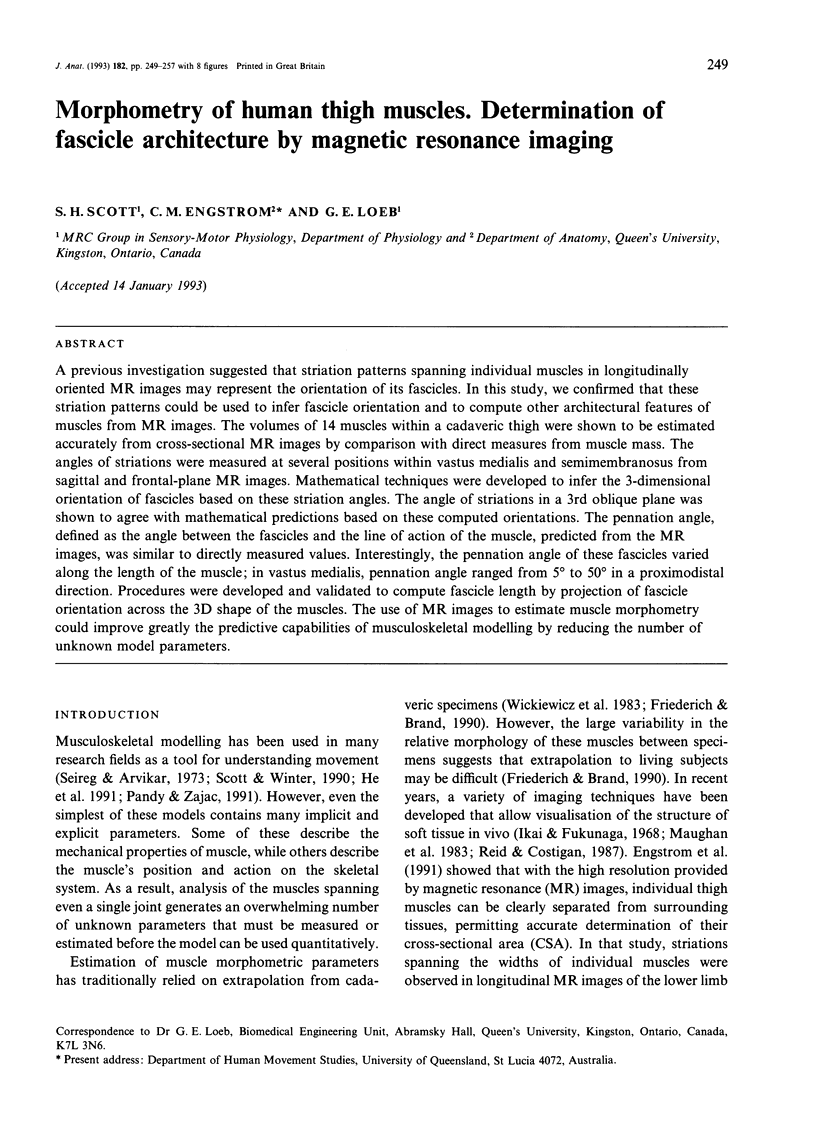Abstract
A previous investigation suggested that striation patterns spanning individual muscles in longitudinally oriented MR images may represent the orientation of its fascicles. In this study, we confirmed that these striation patterns could be used to infer fascicle orientation and to compute other architectural features of muscles from MR images. The volumes of 14 muscles within a cadaveric thigh were shown to be estimated accurately from cross-sectional MR images by comparison with direct measures from muscle mass. The angles of striations were measured at several positions within vastus medialis and semimembranosus from sagittal and frontal-plane MR images. Mathematical techniques were developed to infer the 3-dimensional orientation of fascicles based on these striation angles. The angle of striations in a 3rd oblique plane was shown to agree with mathematical predictions based on these computed orientations. The pennation angle, defined as the angle between the fascicles and the line of action of the muscle, predicted from the MR images, was similar to directly measured values. Interestingly, the pennation angle of these fascicles varied along the length of the muscle; in vastus medialis, pennation angle ranged from 5 degrees to 50 degrees in a proximodistal direction. Procedures were developed and validated to compute fascicle length by projection of fascicle orientation across the 3D shape of the muscles. The use of MR images to estimate muscle morphometry could improve greatly the predictive capabilities of musculoskeletal modelling by reducing the number of unknown model parameters.
Full text
PDF








Images in this article
Selected References
These references are in PubMed. This may not be the complete list of references from this article.
- Engstrom C. M., Loeb G. E., Reid J. G., Forrest W. J., Avruch L. Morphometry of the human thigh muscles. A comparison between anatomical sections and computer tomographic and magnetic resonance images. J Anat. 1991 Jun;176:139–156. [PMC free article] [PubMed] [Google Scholar]
- Friederich J. A., Brand R. A. Muscle fiber architecture in the human lower limb. J Biomech. 1990;23(1):91–95. doi: 10.1016/0021-9290(90)90373-b. [DOI] [PubMed] [Google Scholar]
- Gans C. Fiber architecture and muscle function. Exerc Sport Sci Rev. 1982;10:160–207. [PubMed] [Google Scholar]
- Gundersen H. J., Jensen E. B. The efficiency of systematic sampling in stereology and its prediction. J Microsc. 1987 Sep;147(Pt 3):229–263. doi: 10.1111/j.1365-2818.1987.tb02837.x. [DOI] [PubMed] [Google Scholar]
- Maughan R. J., Watson J. S., Weir J. Strength and cross-sectional area of human skeletal muscle. J Physiol. 1983 May;338:37–49. doi: 10.1113/jphysiol.1983.sp014658. [DOI] [PMC free article] [PubMed] [Google Scholar]
- Mayhew T. M., Olsen D. R. Magnetic resonance imaging (MRI) and model-free estimates of brain volume determined using the Cavalieri principle. J Anat. 1991 Oct;178:133–144. [PMC free article] [PubMed] [Google Scholar]
- Otten E. Concepts and models of functional architecture in skeletal muscle. Exerc Sport Sci Rev. 1988;16:89–137. [PubMed] [Google Scholar]
- Pandy M. G., Zajac F. E. Optimal muscular coordination strategies for jumping. J Biomech. 1991;24(1):1–10. doi: 10.1016/0021-9290(91)90321-d. [DOI] [PubMed] [Google Scholar]
- Reid J. G., Costigan P. A. Trunk muscle balance and muscular force. Spine (Phila Pa 1976) 1987 Oct;12(8):783–786. doi: 10.1097/00007632-198710000-00013. [DOI] [PubMed] [Google Scholar]
- Rugg S. G., Gregor R. J., Mandelbaum B. R., Chiu L. In vivo moment arm calculations at the ankle using magnetic resonance imaging (MRI). J Biomech. 1990;23(5):495–501. doi: 10.1016/0021-9290(90)90305-m. [DOI] [PubMed] [Google Scholar]
- Scott S. H., Winter D. A. A comparison of three muscle pennation assumptions and their effect on isometric and isotonic force. J Biomech. 1991;24(2):163–167. doi: 10.1016/0021-9290(91)90361-p. [DOI] [PubMed] [Google Scholar]
- Seireg A., Arvikar R. J. A mathematical model for evaluation of forces in lower extremeties of the musculo-skeletal system. J Biomech. 1973 May;6(3):313–326. doi: 10.1016/0021-9290(73)90053-5. [DOI] [PubMed] [Google Scholar]



